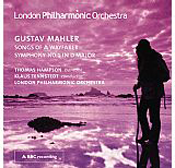Presented in two discrete concerts, Mahler’s Lieder eines fahrenden Gesellen was recorded on 26 September 1991, and the First Symphony from 12 February 1985, with both given at the Royal Festival Hall, London.
A fine interpreter of Mahler’s music, Thomas Hampson was in fine voice for the 1991 performance, and the recording captures his sound quite well. If anything, his voice sounds more forward than the ensemble accompanying him, with the orchestral timbres blended appropriately. Tennstedt’s tempos support the vocal line well, with the interludes sometimes shaped to enhance the texts. With “Ging heut’ morgen übers Feld,” for example, the orchestral slowing before the final strophe is essential to the emphasis that Hampson gives to the final two lines that convey the reversal of tone at the end of the song: “Nun fängt auch mein Glück wohl an? / Nein, nein, das ich mein’, / Mir nimmer blühen kann!” Here the vocalist and conductor must work hand-in-glove, and the performance is exemplary in conveying the shift in mood that is crucial to understanding the song and the rest of the cycle.
As to Hampson’s vocalism, the upper range is quite effective, and demonstrates the kind of lyricism that endeared him to audiences around the world. He shows his capacity to use register as an expressive device, and thus enhances Lieder like these without forcing onto the music affectations that compete with the musical text. A full voice, Hampson is by no means reluctant to start the third song aggressively, and thus suggest the almost hallucinatory state of mind that is crucial for “Ich hab’ ein glühen Messer.” Yet when the music calls for subtlety, he has the capacity to do so with full support, as in the subdued, but never vapid, approach he has given to “Die zwei blauen Augen.” Likewise, Tennstedt’s control of the orchestral never ventures into the singer’s realm, and always serves to support the characteristically Lieder-like style of this orchestral song cycle.
With the recording of Mahler’s First Symphony, a work for which Tennstedt was well known, and this performance predates the esteemed recording of the piece that he made with the Chicago Symphony Orchestra in 1991. As difficult as it can be to describe conductors’ approaches, it is otherwise with Tennstedt. In this work he offers a spaciousness that allows the ensemble to render this demanding score effectively. The relatively slow opening movement allows the various motives to emerge clearly, without forcing the passage that translate the vocal line from “Ging heut’ morgen übers Feld.” At the same time, the pacing gives the brass – especially the trumpet – the opportunity to use a sweet, ringing sound that comes across clearly as an individual color. Likewise, it is a fine tempo for demonstrating the cohesiveness of the strings that Mahler relied on to for the timbral core of much of the first movement.
The second movement, the Scherzo, conveys the sense of a Landler in its easy, almost rocking tempo. This movement has its challenges in the lengthy stretches that have no tempo markings to guide the conductor and, at the same time, shorter passages that are in contrast overly marked by Mahler. The conductor must resolve the issues himself, and Tennstedt has done so well, with nuances of accelerandos and ritardandos that underscore the music without become mannered or unnatural. Ultimately the Scherzo must accelerate the weight of its own texture to the climax that precedes the central, lyrical section, and Tennstedt did so well in this performance, with the center of the movement convincingly delicate.
For some Mahler’s innovation is the ironic funeral march of the third movement, and the recording captures that tone. The slow tempo that Tennstedt took in the opening section forced the unusual solo instruments to become prominent. There is a hint of a reaching in the tuba that does not sometimes occur, and that is entirely appropriate to the style of the piece. Likewise, the Bohemian wind band sounds – sometimes suggested to be influenced by Klezmer ensembles – is sufficiently colorful without becoming a caricature. The details, which are always essential in successful performances of Mahler’s music, are evident here, with trills that are long enough to be heard clearly, but never out of character. Yet the middle section, the passage that Mahler derived from “Die zwei blauen Augen” has a cantabile quality that sets it apart from the wry humor with which the movement opened. Here, the quotation of the song is as crucial to the direction found in the rest of the Symphony as the ritardando – almost a piacere style – that must occur before the final few lines of “Ging heut’ morgen übers Feld.” It is as this point that Tennstedt sets the tone that is resolved and developed in the Finale. Thus, the attacca connection between the third and fourth movements is a critical element that must occur, and it is handled well in this concert performance, where no audience noise is evident.
Again, the aspect of spaciousness that Tennstedt brought to the opening movement is essential to his interpretation of the Finale. Never do the brass sound rushed or pushed prematurely to the brink of their abilities. At the same time, they never overbalance the string textures that Mahler used the movement, but rather color it. Here and there it is possible to hear some entrances that betray the recording as a live performance, but overall it holds together in ways that have sometimes escaped conductors in studio recordings. The anthem-like tone of the final section of the movement takes the listeners to the musical climax without allowing the coda to seem an afterthought. It is an effective performance that deserves to be heard in order to appreciate both Tennstedt’s legacy and the capacity of the London Philharmonic for performing this repertoire.
James L. Zychowicz
